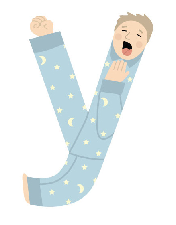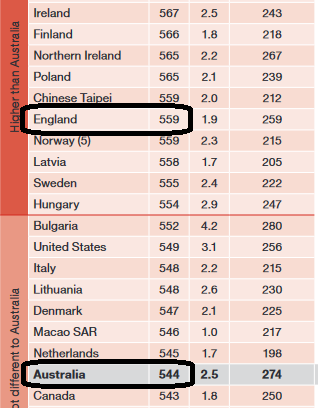Help the government improve adult literacy!
0 Replies
The elephant-in-the-room fact that millions of Australian adults have poor literacy skills is back in the news. Radio National’s AM program reports that the government is concerned millions of adults are missing out on jobs, or are ashamed to even apply for work, because they lack basic reading, writing and numeracy skills.
We’ve known about this problem since the 1996 ABS Adult Literacy Survey, but nobody in the adult literacy sector seemed to know what to do about it. Most of their teachers were sold the same Balanced Literacy story (balancing effective and ineffective) at university as other teachers, so that’s not too surprising.
If you cringed through SBS’s Lost For Words, or have browsed the Reading Writing Hotline website, you already know the adult literacy sector hasn’t really kept up with reading/spelling research. The RWH website’s “Literacy Face To Face” handbook for volunteer adult literacy tutors contains an explanation of how we read which goes beyond the three-cueing nonsense still being taken seriously in far too many schools, saying, “The efficient reader uses four sets of clues…” I kid you not. Section 1, page 4. Read it and weep. The screenshot above is from page 7. I really, truly am quite lost for words.
The Minister for Skills and Training, Brendan O’Connor, has commissioned a study to give the government a clearer picture of where adults lack basic skills. I think it also needs to get a clear picture of what scientific research has discovered about how we actually learn to read and spell, and how well this research is understood and translated into practice in the adult literacy sector. Or not.
If the study assesses adults’ reading and spelling, but not phonological processing skills, it will be about as informative as studying an iceberg by examining the part sticking out of the water, while ignoring the part under the water, holding it up (or not). If you’d like to tell the people designing the research this, or anything else, click here and do it before April 24th.
The Chief Executive of the Australian Industry Group, Innes Willox, says basic skill shortages are a national crisis for employers. In their 2021 survey of over 300 employers, 99% said that they’d been disadvantaged in some way because of basic skill shortages among current or prospective staff.
The Chief Executive of the National Apprentices Employment network says an apprenticeship is not a training program in literacy, numeracy or digital skills, and good candidates are missing out because they lack foundational skills.
There’s no shortage of heavyweights who know we have a serious adult literacy problem. I wish we could be confident there were plenty of people in the adult literacy sector offering serious, evidence-informed solutions. The solutions will probably have to come from outside the sector, from people like the readers of this blog. Please, go for it!
Embedded Picture Mnemonic picture files
0 RepliesSince devising the Spelfabet Embedded Picture Mnemonics, illustrator Cat Macinnes and I have received many requests for products containing them: bookmarks, placemats, friezes, flip charts, cards and posters of different sizes, slideshows, you name it. They’ll even make an appearance on The US Reading League’s Reading Buddies TV show at some stage. The Science of Reading community is a creative one.
Sadly, we don’t have capacity to print, store and mail out lots of hard copy resources containing our mnemonics. If you know of an interested publisher, we’d love to hear from them! Even designing and producing all the downloadable resources people have suggested would be a full-time job for quite a while. We aren’t designers, and already have full-time jobs.
We’re therefore making high-resolution versions of the picture files (.png files, for both PC and Apple) available for people to download and use in creating resources for their own students/caseloads/children. This should make it easy to organise them into any phonics teaching sequence, and print customised materials for any group of beginning readers. Click here to download a zipped folder of the whole set.
Over time, we’ve created alternate versions of some mnemonics, thanks to feedback from purchasers, and in an effort to cater to a surprisingly large audience. Our original ‘e/egg’, ‘o/orange’ and ‘u/undies’ mnemonics were OK for Australian English, but ‘e/echo’, ‘o/octopus and ‘u/up’ were needed for speakers of US English. Recently we’ve discovered that some people aren’t keen on ‘y/yoga’, so we’ve added this nice y/yawn mnemonic to the set.
The zipped folder of picture files includes all the mnemonics we’ve produced to date (except the ‘th/path’ and ‘th/weather’ ones, which weren’t a hit), so when there’s a choice, please use the one that suits you best. In parts of rural Australia where doors aren’t often locked, k/kangaroo is probably a better choice than ‘k/key’. On a surf-mad coast ‘ur/surf’ might make more sense than ‘ur/burn’. In the US, ‘air/hair’ and ‘ear/gears’ aren’t needed, but ‘aw/claw’ is, and ‘wh/whale’ might be (in places where ‘witch’ and ‘which’ aren’t homophones).
When you introduce ‘long’ vowels, you might like to make little strips for student desks like this…
…or a strip like this might suit your students/teaching sequence better:
Hooray, everyone will be able to tailor the set to their accent/sequence/needs, including people who speak Englishes other than Australian, British and American. Cat already put time and talent into drawing all the mnemonics, so you might as well use whichever suit you best (yes, we prefer ‘u/undies’, and people keep asking us to bring it back, ha ha).
Artists should be paid properly for their work, so please respect Cat’s copyright and abide by the terms of use included in the pack. Pricing is based on the assumption that each teacher/therapist/parent who buys the files will use them as they see fit with their class/caseload/family members, and not share them with other professionals or use them for commercial purposes. It’s OK for parents to share printouts with little cousins or the kid next door, but if a school with five Early Years teachers wants to use them in a range of resources across five Early Years classrooms, the school should buy five copies.
The picture files are in .png format, which is the best format for storing high-resolution artwork. They are in a zipped folder which looks like this in the Downloads area of the Spelfabet shop:
Download it to your computer, and you’ll be able to unzip it and access the files, and save them somewhere easy to find and use. Don’t panic if you double-click on a file and it opens in your default picture program and looks a bit weird. The pictures should look as you expect when you drop them into documents. Please reduce picture file size first if they’re too big for your purposes, so the resources you make from them don’t take up lots of space on your computer or take ages to print out. Like adding salt when cooking, it’s easy to make files smaller and lower-resolution, but not reverse the process.
As reading researchers might have predicted, lots of people have told us they’ve been surprised how quickly children have learnt sound-letter relationships using the Spelfabet Embedded Picture Mnemonics. We hope that’s true of any young beginners you try them with, and that you find them quick and easy to turn into great, affordable resources that suit your accent, location and teaching sequence.
“Can I halp you?” The Salary-Celery merger
0 RepliesIf you’re in south-eastern Australia or New Zealand, you’ve probably noticed kids pronouncing words with /e/ (as in ‘egg’) more like /a/ (as in ‘at’) before the sound /l/.
They say things like ‘Can I halp you?’, ‘I falt a bit sick’ and ‘I can do it mysalf’. They pronounce ‘salary’ and ‘celery’ as homophones, hence the name linguists have given this vowel shift: the Salary-Celery merger.
The ‘a’ before /l/ in ‘asphalt’ was being pronounced /e/ when I was scraping my knees on it at school, but ‘a’ pronounced /e/ mainly occurs before /n/, as in ‘any’, ‘many’, ‘secondary’ and ‘dromedary’.
Several other vowels have also morphed a bit before /l/, consider:
- all, ball, call, fall, gall, hall, mall, also, almost, always etc (but not ‘shall’, ‘ally’, ‘alley’, ‘ballad’, ‘gallop’, ‘pallet’, ‘tally’ or ‘alas’).
- walk, talk, chalk, stalk, and baulk (US balk) and caulk (US calk).
- half/halve, calf/calve, behalf (but not ‘salve’ or ‘valve’).
- salt, halt, malt, gestalt, alter, exalt, Walter (but not ‘shalt’).
- fault, vault, cauldron, assault, cauliflower, hydraulic, somersault (but not ‘haul’ or ‘maul’).
The sound /l/ has a vowel-like quality and tends to ‘colour’ the preceding vowel. This is useful for teachers to know, so they can give any confused kids plenty of practice spelling affected words (there’s lots of opportunities to practice writing ‘short vowels’ in a range of phonetic contexts, including before /l/, in Spelfabet Workbook 1)
When kids insist that they hear an /a/ (as in ‘cat’) in ‘halp’, I ask them to say the word in their ‘spelling voice’ (as it’s written), with /e/ (as in ‘red’). Good spellers often say that they pronounce odd spellings a bit weirdly when writing them (Wed-nes-day, bus-i-ness), as a kind of mnemonic. Spelling pronunciations sometimes crop up in comedy too, for example the kniggits in Monty Python and the Holy Grail.
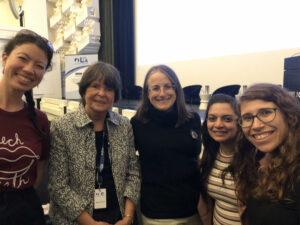
US reading/spelling guru Professor Linnea Ehri was recently here in Melbourne courtesy of Learning Difficulties Australia (the selfie at right proves we met her), and talked about this strategy, which she calls the “Spelling Pronunciation Strategy”. She says that in Connectionist theory, to put a word’s spelling into long-term memory, the letters must be connected to ‘phoneme mates’ in the pronunciations of the word.
To use the Spelling Pronunciation Strategy (AKA “Spelling Voice” in the program Sounds-Write) you separate and say each syllable with stress, and pronounce all the letters. Prof Ehri’s examples were “ex cell ent ”, “lis ten”, “choc o late”, and “Feb ru ary”. She cited two studies (Drake & Ehri, 1984 and Ocal & Ehri, 2017) showing that assigning spelling pronunciations enhanced memory for spellings, in 4th graders and college students.
So in summary, it’s not just harmless to say words in a slightly funny way to halp, sorry, help yourself remember their spellings. It’s officially evidence-based.
Australian phonics screening and funding
0 Replies
I haven’t blogged for months because of a hard third COVID-and-flu-cancellations winter, staff changes (we still need another speech pathologist to help with the crazy waiting list, click here for the job ad), a complete website rewrite, and a death in the family. Sigh.
However, many blog-worthy things have kept happening in the science of reading/spelling world. Did you see any of the incredible, free, online PATTAN 2022 Literacy Symposium presentations? Do you know about LDA‘s seminars by US phonemic awareness guru Linnea Ehri and an explosion of local talent in Melbourne on 23 October, and Sydney on the 25th? Tickets are here (but may be close to sold out). I’m pinching myself to have the honour of MCing the Melbourne seminar.
A couple of recent local announcements prompted an excellent blog from Pam Snow, which you can read here, and I’ve been thinking about them too.
Victorian Phonics Screening Check
In 2023, all Year 1 students in my state will do a phonics screening test, to check they’re learning to sound out words, not just memorise and guess them. Excellent.
Many schools still actively encourage guessing and memorising by using predictable texts, multicueing/three-cueing/MSV strategies, and rote-learning of high frequency word lists, and assess early literacy with Running Records.
A Running Record is a bit like assessing a car by walking around it kicking the tyres. Smart kids with weak decoding can appear to be reading. Phonics screening is like lifting the bonnet and checking there’s actually an engine, and the previous driver wasn’t just doing a Fred Flintstone.
There is a federally-funded Literacy Hub Phonics Screening Check, but Victoria’s Phonics Screening Check will consist of items added to the existing English Online Interview. Only employees of the Victorian Education Department can access this, so I can’t tell you much about it. Victoria’s phonics test was piloted earlier in the year, so I hope valid and reliable test items were identified to add to English Online.
Are the skills to be tested in the curriculum?
Victoria’s Year 1 phonics test will be administered in weeks 3-7 of Term 1, so children will have little more than Foundation (first year of schooling) knowledge of phonics. The two Foundation Reading and Viewing Phonics and Word Knowledge standards in the Victorian Curriculum set a very low standard:
- Recognise all upper- and lower-case letters and the most common sound that each letter represents (VCELA146)
- Blend sounds associated with letters when reading consonant-vowel-consonant words (VCELA147)
Taken at face value, these might restrict the Victorian Year 1 phonics screening test’s words to CVCs with spellings like ‘run’, ‘hop’ and ‘fig’, and pseudowords like ‘nim’, ‘wep’ and ‘vab’. Most children who’ve been taught well in Foundation can read much longer/harder words than that.
I hope the process of formulating and using this test, and adapting the state curriculum to the new, taking-phonics-more-seriously Australian curriculum, will prompt our Education Department to spell out which phoneme-grapheme correspondences and morphemes are expected to be learnt, at least in each of the first three years of schooling.
For example, will early Year 1 students be expected to read words with up to five sounds e.g. ‘crust’ and ‘spend’? Words with consonant digraphs like ‘sh’, ‘ch’ and ‘th’? Any vowel digraphs? What about inflectional morphemes like jump-jumps-jumped-jumping, or soft-softer-softest, and compound words? At the moment, this is unclear.
Phonics screening elsewhere
After a long push for more emphasis on early phonics in the UK, the Year 1 Phonics Screening Check was first done across England in 2012. Past versions of UK phonics screening tests are freely available online, here are links to the 2022, 2019 and 2018 versions (2020 and 2021 tests were didn’t happen because of the COVID-19 pandemic).
A 2018 National Foundation for Educational Research report said of the UK’s 2016 Progress in Reading Literacy (PIRLS) data for Year 4 students, “The average reading score of students in England was significantly higher than in PIRLS 2006 and 2011, and higher than the majority of other countries.” As you can see from the screenshot of the p5 table of an ACER report on PIRLS 2016 here, English children achieved a Mean score of 559, significantly higher than Australia’s 544. Their extra emphasis on assessing and teaching phonics hasn’t done them any harm.
Two Australian states already screen Year 1 children’s decoding skills. South Australia ran a trial in 2017, then rolled a test out to government schools in 2018, and other schools in 2019. New South Wales had a pilot in 2020 and rollout in 2021. Both tests only seem to be accessible to education department staff, but seem similar to the UK test.
In SA in 2021, 67% of children got the expected 28 out of 40 test words/pseudowords correct. In 2018 only 43% of children got 28 items right. Last year, only 2% of kids couldn’t read any words, down from 4% in 2018. Rural, indigenous and lower socioeconomic kids tended to score below average, more details are here.
In NSW in 2021, 56.7% of students were at or above the expected achievement level, up from 43.3% in the 2020 trial. More details are here. I hope we see a similar early lift in skills in Victoria, and that extra attention and resources for rural, indigenous and disadvantaged kids bring their results closer to average.
Administering and following up the test
Australian Year 1 teachers have been given a couple of days and some training to administer the Year 1 Phonics Check, which is a good start, but more needs to be done to help them make optimal use of the test’s data. Gaps in teachers’ knowledge of scientific approaches to teaching early reading and spelling are now being filled by teachers themselves, in droves, in their own time if necessary. They’re voting with their feet for evidence-based practice, and demanding teaching resources to match. Universities, education departments and publishers should take note, and catch up.
We have a state election at the end of November, and the state Opposition has just promised $220 million for systematic, synthetic phonics training and resources. The downstream benefits of preventing reading failure with such measures are massive, for education, employment, the justice system, health and mental health, you name it.
This election promise is most welcome, and in the context of a ~$90 billion (with a b) state budget, I hope all parties contesting the election will match it. After all, this is The Education State, and all children deserve best educational practice.
Play and language: the roots of literacy
9 RepliesDr Carol Westby was a preschool play and language guru back when I was an undergraduate, but I don’t work with preschoolers these days, so haven’t kept track of her recent work. However, lots of people ask me how to prepare preschoolers for literacy success at school.
(more…)The similar-looking word test
43 Replies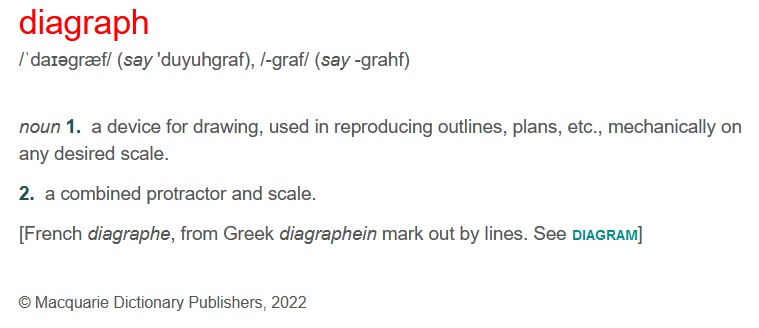
Clients who seem to read well, but spell poorly, are often referred to our service.
Their word-level reading is rarely as good as it seems. While they’re reading connected text, they’re relying on their oral language skills to help them identify the words. Take the supporting context away, by asking them to read lists of words, and they’re usually much less accurate. Their pseudoword decoding/word attack is also often quite weak.
(more…)The Australian Curriculum Version 9.0
29 Replies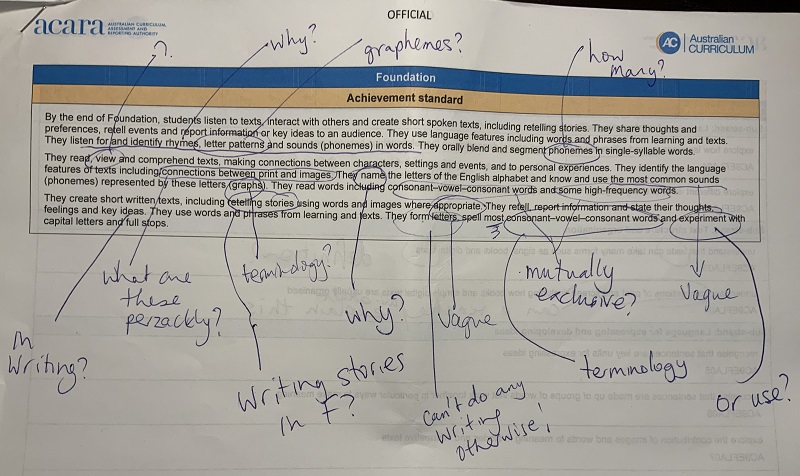
Prompted by an interesting Radio National interview with ACARA CEO David de Carvalho, I’ve been trying to get my head around early literacy in version 9.0 of the Australian Curriculum. It’s a definite improvement on previous versions, so WELL DONE to all those who argued for evidence-based practice, sorry I was too busy swimming through COVID-related mud to help.
My main interest is in the English strand for Foundation to Year 2, the vital learning-to-spell-and-decode years. Have predictable texts, multicueing and rote-memorisation of high-frequency wordlists finally been dumped? How specific is it about which phonemic awareness, phonics and morphology knowledge/skills to teach in the first three years? What does it say about spelling?
(more…)

